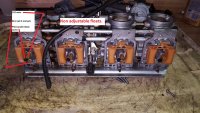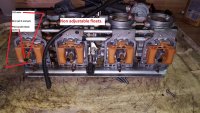My bike wouldn't rev past 5,000 rpms, so I decided to do a cleaning on the carbs. I noticed a few things while putting them back together.
1981 CB750C Motorcycle
VB42A Carbs
1. While all of the jets are supposed to be 102, one is marked 68 (the hole is a different size too) and I have no idea why this is. Obviously someone worked on it in the past and put it in, but was it for a reason? Should I keep it in?
2. When I put everything back together with the original parts, the bike reved up to 7,000 rpms, which is better, however one of the tubes leaks gas profusely and I don't know if that is normal when starting the bike up for the first time after a cleaning. At first it started with the left two nipples, then stopped. Now the upper tube began to leak without stopping unless I turned off the gas switch. See video. Do I need to wait it out and eventually it will stop? What do I do in this situation?
https://www.youtube.com/watch?v=MBWi7gtyM6o
Thank you for your help!
1981 CB750C Motorcycle
VB42A Carbs
1. While all of the jets are supposed to be 102, one is marked 68 (the hole is a different size too) and I have no idea why this is. Obviously someone worked on it in the past and put it in, but was it for a reason? Should I keep it in?
2. When I put everything back together with the original parts, the bike reved up to 7,000 rpms, which is better, however one of the tubes leaks gas profusely and I don't know if that is normal when starting the bike up for the first time after a cleaning. At first it started with the left two nipples, then stopped. Now the upper tube began to leak without stopping unless I turned off the gas switch. See video. Do I need to wait it out and eventually it will stop? What do I do in this situation?
https://www.youtube.com/watch?v=MBWi7gtyM6o
Thank you for your help!






